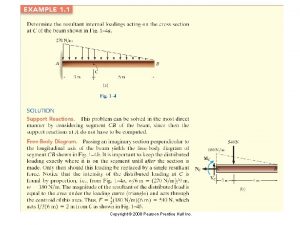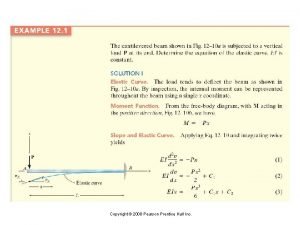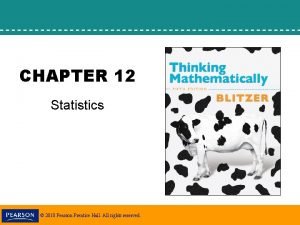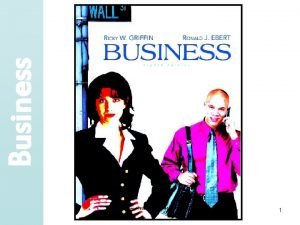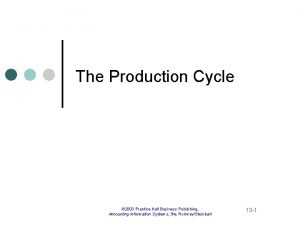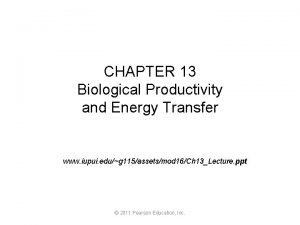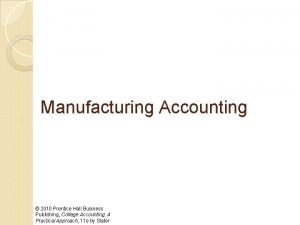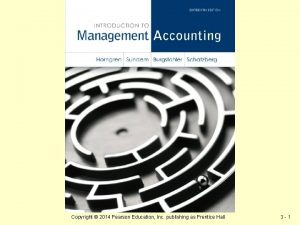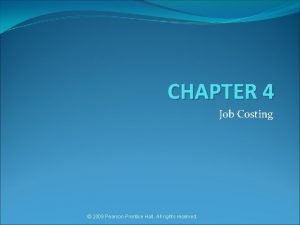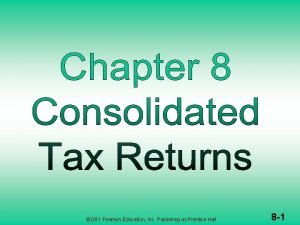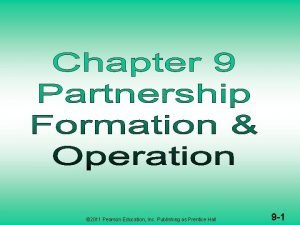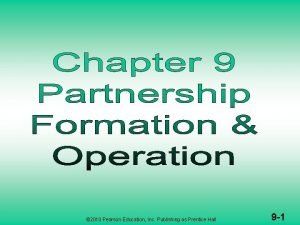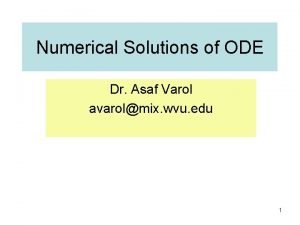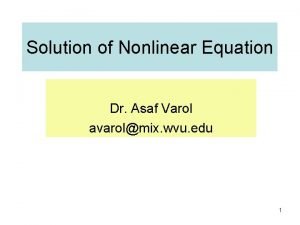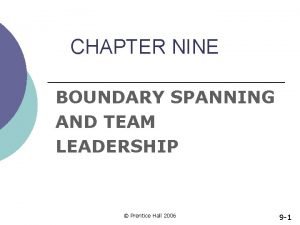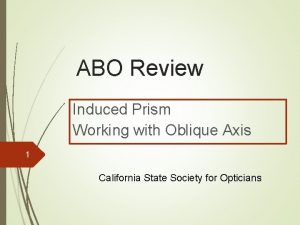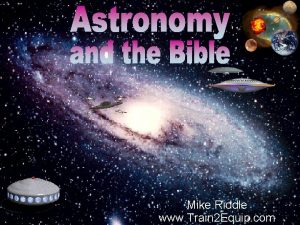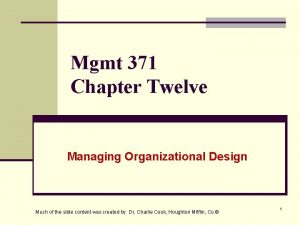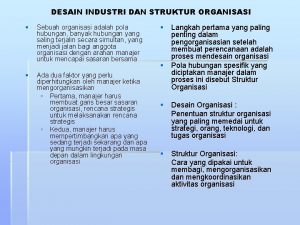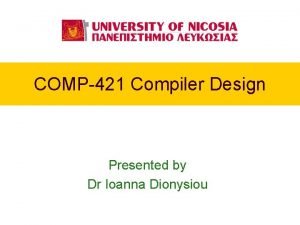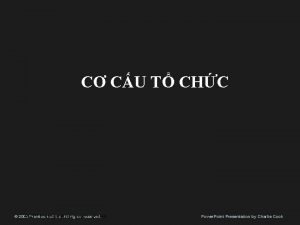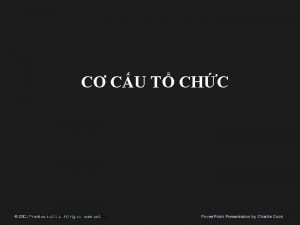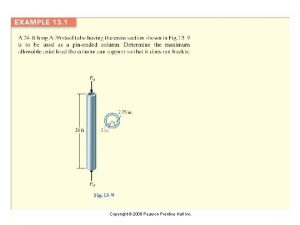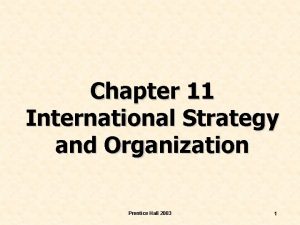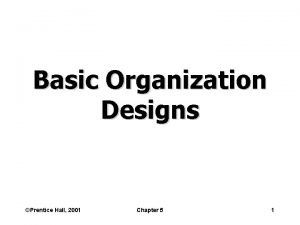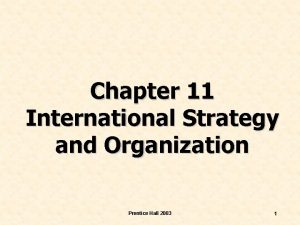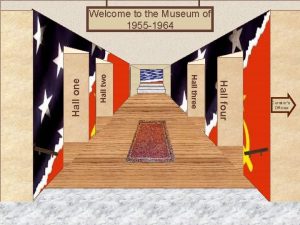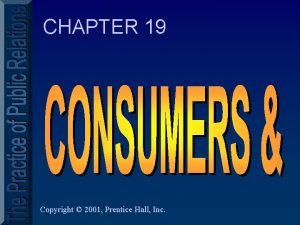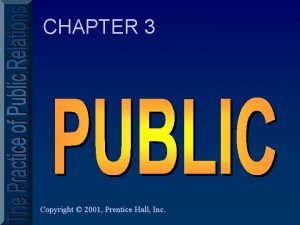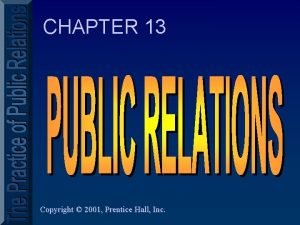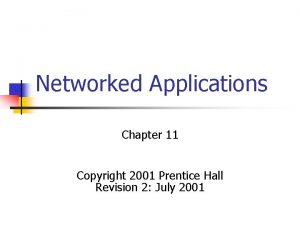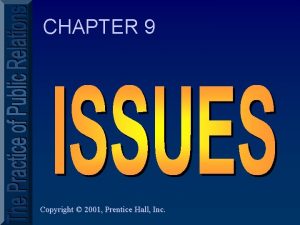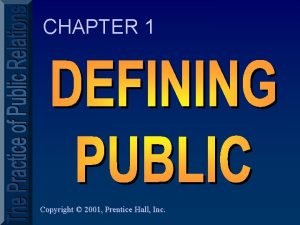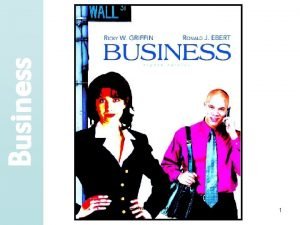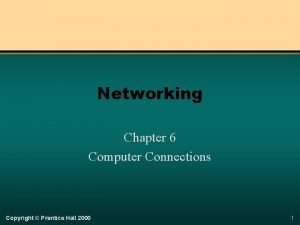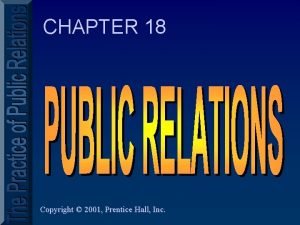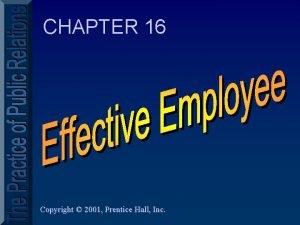Organization design CHAPTER 11 Copyright 2019 Prentice Hall



















































- Slides: 51

Organization design CHAPTER 11 Copyright © 2019 Prentice Hall, Inc. All rights reserved. 1– 1

Learning Objectives 11. 1 Describe six key elements in organizational design. 11. 2 Contrast mechanistic and organic structures. 11. 3 Discuss the contingency factors that favor either the mechanistic model or the organic model of organizational design. 11. 4 Describe traditional organizational design options. 11. 5 Discuss organizing flexibility in the twenty-first century. Develop your skill at acquiring and using power. Know how to stay connected and “in the loop” when working remotely. Copyright © 2019 Prentice Hall, Inc. All rights reserved.

Defining Organizational Structure • Organizational Structure Ø The formal arrangement of jobs within an organization. • Organizational Design Ø A process involving decisions about six key elements: v Work specialization v Departmentalization v Chain of command v Span of control v Centralization and decentralization v Formalization Copyright © 2019 Prentice Hall, Inc. All rights reserved. 10– 3

Some Purposes of Organizing 1. Divides work to be done into specific jobs and departments. 2. Assigns tasks and responsibilities associated with individual jobs. 3. Coordinates diverse organizational tasks. 4. Clusters jobs into units. 5. Establishes relationships among individuals, groups, and departments. 6. Establishes formal lines of authority. 7. Allocates and deploys organizational resources. Figure 10. 1 Copyright © 2019 Prentice Hall, Inc. All rights reserved. 10– 4

Organizational Structure • Work Specialization Ø The degree to which tasks in the organization are divided into separate jobs with each step completed by a different person. v Overspecialization can result in human diseconomies from boredom, fatigue/tiredness, stress, poor quality, increased absenteeism, and higher turnover. Copyright © 2019 Prentice Hall, Inc. All rights reserved. 10– 5

Exhibit 11 -2 Economies and Diseconomies of Work Specialization Exhibit 11 -2 shows the economies and diseconomies of work specialization. Copyright © 2019 Prentice Hall, Inc. All rights reserved. Copyright © 2018, 2016, 2014 Pearson Education, Inc. All Rights Reserved

Departmentalization by Type • Functional Ø Grouping jobs by functions performed • Product Ø Grouping jobs by product line • Geographic Ø Grouping jobs on the basis of territory or geography Copyright © 2019 Prentice Hall, Inc. All rights reserved. • Process Ø Grouping jobs on the basis of product or customer flow • Customer Ø Grouping jobs by type of customer and needs 10– 7

Functional Departmentalization • Advantages • Efficiencies from putting together similar specialties and people with common skills, knowledge, and orientations • Coordination within functional area • In-depth specialization • Disadvantages • Poor communication across functional areas • Limited view of organizational goals Copyright © 2019 Prentice Hall, Inc. All rights reserved. Figure 10. 2 a 10– 8

Geographical Departmentalization • Advantages • More effective and efficient handling of specific regional issues that arise • Serve needs of unique geographic markets better • Disadvantages • Duplication of functions • Can feel isolated from other organizational areas Copyright © 2019 Prentice Hall, Inc. All rights reserved. Figure 10. 2 b 10– 9

Product Departmentalization + + + – – Allows specialization in particular products and services Managers can become experts in their industry Closer to customers Duplication of functions Limited view of organizational goals Figure 10. 2 c Source: Bombardier Annual Report. Copyright © 2019 Prentice Hall, Inc. All rights reserved. Figure 10. 2 c 10– 10

Process Departmentalization +More efficient flow of work activities –Can only be used with certain types of products Figure 10. 2 d Copyright © 2019 Prentice Hall, Inc. All rights reserved. 10– 11

Customer Departmentalization + Customers’ needs and problems can be met by specialists - Duplication of functions - Limited view of organizational goals Figure 10. 2 d Copyright © 2019 Prentice Hall, Inc. All rights reserved. 10– 12

Cross-Functional Team • Cross-functional team: a work team composed of individuals from various functional specialties. • Especially used as work tasks have become more complex and diverse skills are needed to accomplish those tasks. Copyright © 2019 Prentice Hall, Inc. All rights reserved. 10– 13

LEADER MAKING A DIFFERENCE • Chairman and CEO of Haier Group, Zhang is considered to be one of China’s leading corporate executives. He was responsible for turning his company into a global brand with almost $30 billion in revenue. He did this by promoting efficient mass production, setting a high standard of quality and by using self-managed groups. Zhang believes success requires a different competency. So he reorganized the company into self-managed groups, each devoted to a customer or group of similar customers. • What can you learn from this leader making a difference? Copyright © 2019 Prentice Hall, Inc. All rights reserved. 10– 14

Organization Structure (cont’d) • Chain of Command ØThe continuous line of authority that extends from upper levels of an organization to the lowest levels of the organization and clarifies who reports to who. Copyright © 2019 Prentice Hall, Inc. All rights reserved. 10– 15

Organization Structure (cont’d) • Authority ØThe rights inherent in a managerial position to tell people what to do and to expect them to do it. • Responsibility ØThe obligation or expectation to perform. • Unity of Command ØThe concept that a person should have one boss and should report only to that person. Copyright © 2019 Prentice Hall, Inc. All rights reserved. 10– 16

Organization Structure (cont’d) • Span of Control Ø The number of employees who can be effectively and efficiently supervised by a manager. Ø Width of span is affected by: v Skills and abilities of the manager. v Employee characteristics: personality, skills. . v Characteristics of the work being done. v Similarity of tasks. v Complexity of tasks. v Standardization of tasks. v Physical proximity of subordinates. Copyright © 2019 Prentice Hall, Inc. All rights reserved. 10– 17

Contrasting Spans of Control Figure 10. 3 Copyright © 2019 Prentice Hall, Inc. All rights reserved. 10– 18

Organization Structure (cont’d) • Centralization Ø The degree to which decision-making is concentrated at a single point in the organizations. v Organizations in which top managers make all the decisions and lower-level employees simply carry out those orders. • Decentralization Ø Organizations in which decision-making is pushed down to the managers who are closest to the action. • Employee Empowerment Ø Increasing the decision-making made by employees. Copyright © 2019 Prentice Hall, Inc. All rights reserved. 10– 19

Factors that Influence the Amount of Centralization • More Centralization Ø Environment is stable. Ø Lower-level managers are not as capable or experienced at making decisions as upper-level managers. Ø Lower-level managers do not want to have a say in decisions. Ø Decisions are significant. Ø Organization is facing a crisis or the risk of company failure. Ø Company is large but same geographical area. Ø Effective implementation of company strategies depends on managers retaining say over what happens. Figure 10. 4 a Copyright © 2019 Prentice Hall, Inc. All rights reserved. 10– 20

Factors that Influence the Amount of Decentralization • More Decentralization Ø Environment is complex, dynamic, uncertain. Ø Lower-level managers are capable and experienced at making decisions. Ø Lower-level managers want a voice in decisions. Ø Decisions are relatively minor. Ø Corporate culture is open to allowing managers to have a say in what happens. Ø Company is geographically dispersed. Ø Effective implementation of company strategies depends on managers having involvement and flexibility to make decisions. Figure 10. 4 b Copyright © 2019 Prentice Hall, Inc. All rights reserved. 10– 21

Organization Structure (cont’d) • Formalization ØThe degree to which jobs within the organization are standardized and the extent to which employee behavior is guided by rules and procedures. v. Highly formalized jobs offer little discretion over what is to be done. v. Low formalization means fewer constraints on how employees do their work. Copyright © 2019 Prentice Hall, Inc. All rights reserved. 10– 22

Organizational Design Decisions/Models • Mechanistic Organization Ø A rigid and tightly controlled structure v High specialization v Rigid departmentalization v Narrow spans of control v High formalization v Limited information network (downward) v Low decision participation Copyright © 2019 Prentice Hall, Inc. All rights reserved. • Organic Organization Ø Highly flexible and adaptable structure v Non-standardized jobs v Fluid team-based structure v Little direct supervision v Minimal formal rules v Open communication network v Empowered employees 10– 23

Mechanistic versus Organic Organization Figure 10. 5 Copyright © 2019 Prentice Hall, Inc. All rights reserved. 10– 24

Contingency Factors Affect Structure • Structure is influenced by: Ø Overall strategy of the organization v Organizational structure follows strategy. Ø Size of the organization v Firms change from organic to mechanistic organizations as they grow in size. Ø Technology use by the organization v Firms adapt their structure to the technology they use. Ø Degree of environmental uncertainty v Dynamic environments require organic structures; mechanistic structures need stable environments. Copyright © 2019 Prentice Hall, Inc. All rights reserved. 10– 25

Contingency Factors Affect Structure • Strategy Frameworks: organic or mechanistic Ø Innovation v Pursuing competitive advantage through meaningful and unique innovations favors an organic structuring. Ø Cost minimization v Focusing on tightly controlling costs requires a mechanistic structure for the organization. Ø Imitation v Minimizing risks and maximizing profitability by copying market leaders requires both organic and mechanistic elements in the organization’s structure. Copyright © 2019 Prentice Hall, Inc. All rights reserved. 10– 26

Contingency Factors Affect Structure • Strategy and Structure Ø Achievement of strategic goals is facilitated by changes in organizational structure that accommodate and support change. • Size and Structure Ø As an organization grows larger, its structure tends to change from organic to mechanistic with increased specialization, departmentalization, centralization, and rules and regulations. Copyright © 2019 Prentice Hall, Inc. All rights reserved. 10– 27

Contingency Factors Affect Structure • Technology and Structure Ø Organizations adapt their structures to their technology. Ø Woodward’s classification of firms based on the complexity of the technology employed: v Unit production: describes the production of items in units or small batches. v Mass production: describes large-batch manufacturing. v Process production in continuous process of outputs, most technologically complex group. Ø Routine technology = mechanistic organizations Ø Non-routine technology = organic organizations Copyright © 2019 Prentice Hall, Inc. All rights reserved. 10– 28

Woodward’s Findings on Technology, Structure, and Effectiveness Figure 10. 6 Copyright © 2019 Prentice Hall, Inc. All rights reserved. 10– 29

Interpretation to previous table v Unit production: related to small units, few layers in the structure, simple activities and process and few departments and low formalization: organic. v Mass production: medium or large business size, 2 -3 layers in the structure, and many departments and high formalizations, mass production: mechanic. E. g. , car makers. v Process production: many processes sequential, Small business or medium, and low formalization: organic. Software industry. Copyright © 2019 Prentice Hall, Inc. All rights reserved. 10– 30

Contingency Factors Affect Structure • Environmental Uncertainty and Structure Ø Mechanistic organizational structures tend to be most effective in stable and simple environments. Ø The flexibility of organic organizational structures is better suited for dynamic and complex environments. Copyright © 2019 Prentice Hall, Inc. All rights reserved. 10– 31

Common Organizational Designs • Traditional Designs Ø Simple structure v Low departmentalization, wide spans of control, centralized authority, little formalization Ø Functional structure v Departmentalization by function – Operations, finance, human resources, and product research and development Ø Divisional structure v Composed of separate business units or divisions with limited autonomy under the coordination and control the parent corporation. Copyright © 2019 Prentice Hall, Inc. All rights reserved. 10– 32

Strengths and Weaknesses of Common Traditional Organizational Designs Figure 10. 7 Copyright © 2019 Prentice Hall, Inc. All rights reserved. 10– 33

Organizational Designs (cont’d) • Contemporary Organizational Designs Ø Team structures v The entire organization is made up of work groups or self-managed teams of empowered employees, e. g. IT business developers and construction companies. Ø Matrix structures v Specialists for different functional departments are assigned to work on projects led by project managers. v Matrix participants have two managers. Ø Project structures v Employees work continuously on projects; moving on to another project as each project is completed. Copyright © 2019 Prentice Hall, Inc. All rights reserved. 10– 34

A Matrix Organization in an Aerospace Firm Figure 10. 9 Copyright © 2019 Prentice Hall, Inc. All rights reserved. 10– 35

Organizational Designs (cont’d) • Contemporary Organizational Designs (cont’d) Ø Boundaryless Organization v An flexible and unstructured organizational design that is intended to break down external barriers between the organization and its customers and suppliers. v Removes internal (horizontal) boundaries: – Eliminates the chain of command – Has limitless spans of control – Uses empowered teams rather than departments v Eliminates external boundaries: – Uses virtual, network, and modular organizational structures to get closer to stakeholders. Copyright © 2019 Prentice Hall, Inc. All rights reserved. 10– 36

Removing Boundaries • How To apply Boundary less Organization • Virtual Organization Ø An organization that consists of a small core of full-time employees and that temporarily hires specialists to work on opportunities that arise. • Network Organization Ø A small core organization that outsources its major business functions (e. g. , manufacturing) in order to concentrate what it does best. • Modular Organization (assembly lines, e. g. , Toyota) Ø A manufacturing organization that uses outside suppliers to provide product components for its final assembly operations. Copyright © 2019 Prentice Hall, Inc. All rights reserved. 10– 37

Organizational Designs (cont’d) • The Learning Organization Ø An organization that has developed the capacity to continuously learn, adapt, and change through the practice of knowledge management by employees. Ø Characteristics of a learning organization: v An open team-based organization design that empowers employees v Extensive and open information sharing v Leadership that provides a shared vision of the organization’s future, support and encouragement v A strong culture of shared values, trust, openness, and a sense of community. Copyright © 2019 Prentice Hall, Inc. All rights reserved. 10– 38

Characteristics of a Learning Organization Figure 10. 10 Copyright © 2019 Prentice Hall, Inc. All rights reserved. 10– 39

Homework • P. 4, 5 questions 1 -8 Copyright © 2019 Prentice Hall, Inc. All rights reserved. 10– 40

Task Forces • Task force (or ad hoc committee): a temporary committee or team formed to tackle a specific short-term problem affecting several departments • Open innovation: opening up the search for new ideas beyond the organization’s boundaries and allowing innovations to easily transfer inward and outward Copyright © 2019 Prentice Hall, Inc. All rights reserved. 10– 41

Exhibit 11 -10 Benefits and Drawbacks of Open Innovation Benefits Gives customers what they want—a voice Drawbacks High demands of managing the process Allows organizations to respond to complex Extensive support needed problems Nurtures internal and external relationships Cultural challenges Brings focus back to marketplace Greater need for flexibility Provides way to cope with rising costs and uncertainties of product development Crucial changes required in how knowledge is controlled and shared Copyright © 2019 Prentice Hall, Inc. All rights reserved. Copyright © 2018, 2016, 2014 Pearson Education, Inc. All Rights Reserved

Telecommuting • Telecommuting: a work arrangement in which employees work at home and are linked to the workplace by computer Copyright © 2019 Prentice Hall, Inc. All rights reserved. 10– 43

Compressed Workweeks, Flextime, and Job Sharing • Compressed workweek: a workweek where employees work longer hours per day but fewer days per week • Flextime (or flexible work hours): a scheduling system in which employees are required to work a specific number of hours a week but are free to vary those hours within certain limits • Job sharing: the practice of having two or more people split a full-time job Copyright © 2019 Prentice Hall, Inc. All rights reserved. 10– 44

The Contingent Workforce • Contingent workers: temporary, freelance, or contract workers whose employment is contingent on demand for their services Copyright © 2019 Prentice Hall, Inc. All rights reserved. 10– 45

Review Learning Objective 11. 1 • Describe six key elements in organizational design. 1. Work specialization 2. Departmentalization 3. Chain of command 4. Span of control 5. Centralization/decentralization 6. Formalization Copyright © 2019 Prentice Hall, Inc. All rights reserved. 10– 46

Review Learning Objective 11. 2 • Contrast mechanistic and organic structures. Ø Mechanistic structure: rigid, tightly controlled Ø Organic structure: highly adaptable, flexible Copyright © 2019 Prentice Hall, Inc. All rights reserved. 10– 47

Review Learning Objective 11. 3 • Discuss the contingency factors that favor either the mechanistic model or the organic model of organizational design. Ø An organization’s structure should support the strategy. Ø Structure can be affected by size and technology. Ø Organic structure is most effective with unit production and process production technology. Ø Mechanistic structure is most effective with mass production technology. Copyright © 2019 Prentice Hall, Inc. All rights reserved. 10– 48

Review Learning Objective 11. 4 • Describe traditional organizational design options. Ø Simple structure: little departmentalization, wide spans of control, authority centralized in one person, and little formalization. Ø Functional structure Ø Divisional structure Copyright © 2019 Prentice Hall, Inc. All rights reserved. 10– 49

Review Learning Objective 11. 5 • Discuss organizing for flexibility in the twentyfirst century. Ø Structures: v Team v Matrix v Project Ø Boundaryless organization Ø Virtual organization Ø Compressed workweeks, flextime, job sharing Ø Contingent workforce Copyright © 2019 Prentice Hall, Inc. All rights reserved. 10– 50

Copyright © 2019 Prentice Hall, Inc. All rights reserved. 10– 51
 2005 pearson prentice hall inc
2005 pearson prentice hall inc 2008 pearson prentice hall inc
2008 pearson prentice hall inc Prentice hall inc
Prentice hall inc 2008 pearson prentice hall inc
2008 pearson prentice hall inc Pearson prentice hall
Pearson prentice hall Prentice hall inc
Prentice hall inc Prentice hall careers
Prentice hall careers Prentice hall america pathways to the present
Prentice hall america pathways to the present Pearson education, inc. publishing as prentice hall
Pearson education, inc. publishing as prentice hall Prentice hall publishing
Prentice hall publishing Prentice hall african american history
Prentice hall african american history Prentice hall physical science: concepts in action
Prentice hall physical science: concepts in action Pearson education inc publishing as pearson prentice hall
Pearson education inc publishing as pearson prentice hall Ocean fisheries
Ocean fisheries Pearson prentice hall
Pearson prentice hall 2005 pearson prentice hall inc
2005 pearson prentice hall inc Pearson education inc publishing as pearson prentice hall
Pearson education inc publishing as pearson prentice hall Common name of arthropoda
Common name of arthropoda Prentice hall business publishing
Prentice hall business publishing Pearson education inc. publishing as prentice hall
Pearson education inc. publishing as prentice hall 2012 pearson education inc
2012 pearson education inc 2012 pearson education inc
2012 pearson education inc Chapter 4 job costing
Chapter 4 job costing 2011 pearson education inc
2011 pearson education inc 2011 pearson education inc
2011 pearson education inc Pearson education 2010
Pearson education 2010 2010 pearson education inc
2010 pearson education inc It fw
It fw Process organization in computer organization
Process organization in computer organization Alternating pattern essay
Alternating pattern essay Varol prentice
Varol prentice Jules prentice
Jules prentice Varol prentice
Varol prentice Joshua prentice
Joshua prentice Prentice boundaries
Prentice boundaries Prentice rule formula
Prentice rule formula Isaiah prentice riddle
Isaiah prentice riddle Dennis prentice
Dennis prentice Lecture hall acoustic design
Lecture hall acoustic design Cobit 2019 exam questions
Cobit 2019 exam questions 10262 2019
10262 2019 Visual communication design study design
Visual communication design study design Gcse design and technology coursework examples 2019
Gcse design and technology coursework examples 2019 H-form design
H-form design Industrial design organization
Industrial design organization File organization and database design
File organization and database design Storage organization in compiler design
Storage organization in compiler design Basic computer design
Basic computer design Computer organization and design ppt
Computer organization and design ppt Dimensions of organization design
Dimensions of organization design Forces reshaping organizations
Forces reshaping organizations Complete computer description in computer organization
Complete computer description in computer organization


